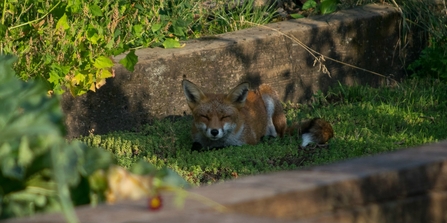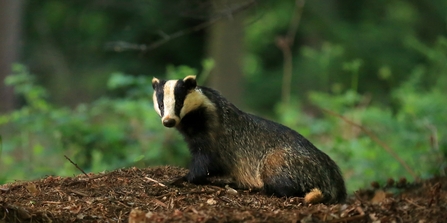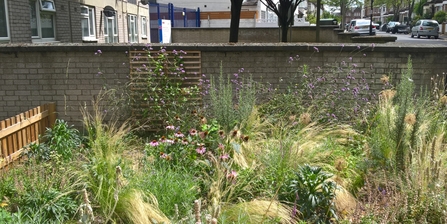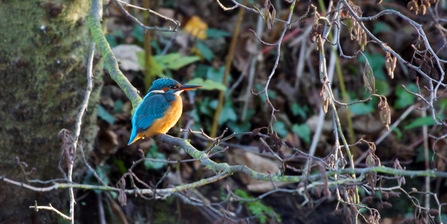
Image credits: Saharla G, workshop attendee
Our views on the big issues affecting London's wildlife
This page provides details on our policies and position statements covering some of the biggest issues affecting wildlife in London.
If you wish to know our position on an issue not listed here, please email enquiries@wildlondon.org.uk.
Foxes in London

Fox at Centre for Wildlife Gardening © Daniel Greenwood
The red fox is the most widespread and abundant wild carnivore in the world. Found throughout Britain, it is very common in London, and more so than in the surrounding countryside. This is not surprising considering how adaptable red foxes are when faced with a changing environment. Many people living in London take great pleasure in seeing a truly wild animal in their neighbourhood. However, sometimes foxes can become a nuisance, and inevitably there are calls to remove or cull them.
London Wildlife Trust opposes any measures to hunt, eradicate, or cull foxes within London. Read our full policy here.
Badgers and bovine TB

Badger © Jon Hawkins/Surrey Hills Photography
The badger, commonly found in many outer suburbs of London, can be described as one of Britain’s best-loved and iconic mammals. However, they have become central to a controversial political and scientific debate surrounding the presence and spread of bovine tuberculosis (TB) in cattle. This is leading to calls for culls and eradication of badger populations from areas where bovine TB is present, despite conflicting evidence as to whether this would work.
London Wildlife Trust does not support a cull of badgers as a means to control and eradicate bovine TB. Read our full policy here.
Ring-necked parakeets

Parakeet credit Neil Phillips
The ring-necked, or rose-ringed, parakeet has been introduced into the wild in Britain as a result of escapes and deliberate releases of captive birds. Now commonly found in parts of London, where its bright plumage and noisy calls have brought it to the attention of many, there are some concerns as to whether they might be impacting on other wildlife. Read our policy on ring-necked parakeets here.
Magpies and crows

WildNet - Zsuzsanna Bird
Corvids (crows, magpies, and allies) are medium to large bird that have adapted well to urban environments largely because of their intelligence. However they are sometimes viewed as pests or problematic species, primarily because they will take eggs and nestlings of other birds; magpies in particular are often viewed with suspicion or contempt for their behaviour. There are often calls to control them because of their perceived impacts on more popular species. Read our policies on magpies and crows here.
Gardens

Urban garden, Lambeth
Almost a quarter of London is made up of gardens, which represent an important resource for the capital’s wildlife. Gardens can provide vital habitats for wildlife and a strong network of wildlife and climate friendly gardens stretching across the city will provide room for species to move freely and adapt to our changing climate.
London Wildlife Trust will work to maintain the extent and value of London’s gardens for the benefit of people and wildlife. Read our full policy here.
London's Green Belt
Hutchinson's Bank © Mathew Frith
London’s Green Belt is integral to the vision of London as a sustainable, green world city based on a strategic network of open spaces. It provides both a buffer and a link between suburban London and the wider countryside, helping to prevent further urban sprawl. It also serves to support ecological networks and significant green corridors for wildlife, offering people the chance to enjoy the countryside on London’s doorstep. Nevertheless, the quality of land within the Green Belt is variable, and demands for development continue to place pressure upon it. A new vision for the Green Belt is required to make it fit for purpose in the 21st century.
London Wildlife Trust will oppose inappropriate use, development, damage, or loss of Green Belt land. Read our full policy here.
High Speed Two

High Speed Two (HS2) is a new £56billion railway that will provide a high-speed link between London and Birmingham by 2026. London Wildlife Trust is working to ensure any impact on wildlife is minimised.
Nature Reserves

Kingfisher at Wilderness Island © David Fielding
London Wildlife Trust manages a portfolio of nature reserves across London. These are managed as a means to directly conserve habitats and species, to engage people with nature through direct experience, volunteering and outdoor education, and as a way to demonstrate best practice in order to influence landowners and others.
London Wildlife Trust manages nature reserves in London to further the conservation of habitats, species and other natural features. Read our full policy here.
Railway Lineside
New Cross Gate Cutting
There are more than 800km of surface railway lines in London, of which a significant proportion support linesides with habitat of wildlife interest. These will include areas of grassland, scrub, recent woodland and wasteland communities, together with built infrastructure, such as walls and bridges that will support some plants. The linesides are subject to management by the various railway companies to ensure that they are operationally safe. However, this often leads to controversy due to the scale, timing, and/or impacts of works to local residents.
London Wildlife Trust will proactively work with railway companies to ensure biodiversity on linesides is protected and enhanced. Read our full policy here.
Foraging on reserves

Wild garlic
Photo credit: Don Sutherland
London Wildlife Trust manages nearly 40 nature reserves across London to conserve habitats and species and engage people with nature. Our reserves support a wide variety of species, including a number of edible plants and fungi. In recent years, picking wild plants and fungi for cooking and herbal medicine has regained popularity in Britain, and London now has a growing number of foragers. Small-scale foraging is rarely an issue when carried out responsibly, and can have a positive role in connecting people with nature. However, picking wild plants and fungi in an unsustainable manner can damage wildlife and compromise the conservation goals of the Trust, as well as potentially breaking the law. We advise people to consider the impact of their own actions as sites in London are well used and if every person who visits a site picks plants it would have an accumulative detrimental impact. Read our full policy here
